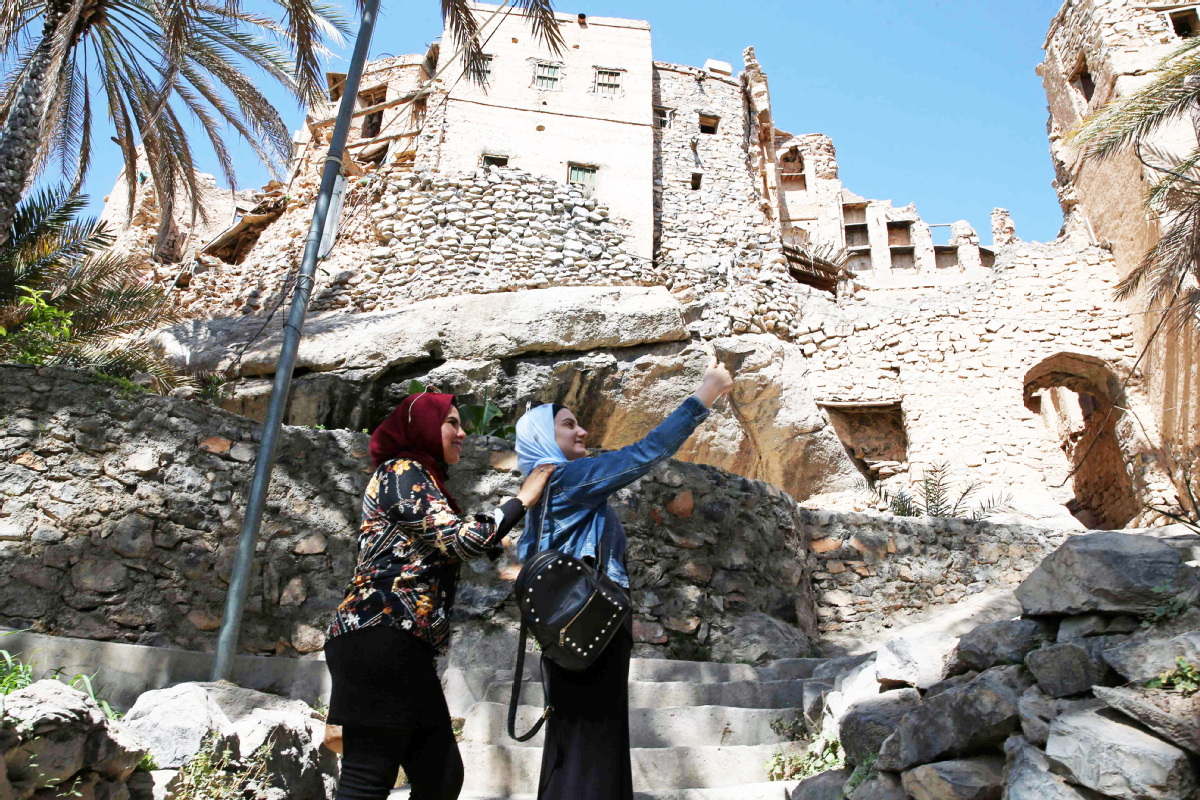Oman pins hope on travel sector and Chinese tourists
Oman pins hope on travel sector and Chinese tourists China Daily


Oman Looks to China to Boost Tourism and Achieve Sustainable Development Goals
Tourists visit the village of Misfat al-Abriyeen on the escarpments of Oman’s Grand Canyon. MOHAMMED MAHJOUB/FOR CHINA DAILY

In a quest to enhance tourism’s contribution to the country’s GDP over the next decade, Oman is looking to China – the world’s largest source of market for outbound travel.
The pivot to tourism is part of Oman Vision 2040, a plan to diversify its economy similar to those in place in Gulf neighbors Saudi Arabia and the United Arab Emirates (UAE).
Building Relations with China
Muscat has announced plans to establish a tourism representative office in China to build on the visitor momentum it was experiencing before the pandemic.
Industry experts and observers said Oman should consider partnering with reputable companies and using their proven expertise and experience to better identify its target market within China.
“Oman understands the growing role of China in the region and wants to co-opt itself in strengthening its relations with Beijing. Obviously, there’s an element of policy alignment between the two countries,” Mohammed Al-Hajri, a Gulf-China relations researcher at the University of London, told China Daily.
“On the other side, Oman is seeking investments in these targeted sectors and the potential opportunities that China can provide is appealing to the Omani authorities,” said the Muscat-based researcher.
Efforts to Attract Chinese Travelers
Earlier this month, The Muscat Daily newspaper reported that the Ministry of Heritage and Tourism (MHT) was inviting international companies to establish a tourism representative office in China to attract Chinese travelers to the sultanate.
It said the move was part of the MHT’s comprehensive efforts to develop and revamp marketing plans and programs aimed at promoting Oman’s tourist attractions through its global offices.
The proposed China office is also meant to strengthen relations among local partners, and interested parties have until Aug 1 to submit bids for consideration.
Sustainable Development Goals
Oman hopes to increase the tourism sector’s GDP contribution to 5 percent by 2030, double that of 2021. According to MHT figures, Oman witnessed a 141 percent growth in Chinese tourists before the COVID-19 pandemic, increasing from 44,580 in 2018 to 107,446 in 2019.
Promoting Oman in China
Last year, the MHT organized a virtual program – the “Oman Tourism China Roadshow 2022” – where it held an online match-making event bringing together Chinese buyers and exhibitors from Oman.
Ken Shen, business development manager at Shenzhen Hang Lu Travel Technology Company Limited, said that the Omani tourism representative could look at options such as finding established companies with good reputations.
The travel technology company operates Flightroutes24, a B2B platform founded in Hong Kong in 2014, and has a research and development center in Shenzhen.
Shen said such expertise could help Oman better identify the target market it wants to attract. Within China, Omani tourism could also consider hiring a designated contact person who may understand the local market better to foster long-term engagements.
Shen noted that Oman “has a good geographical location”, adding that Chinese people’s perception of the Middle East is changing.
In June alone, his company’s platform helped issue 500 tickets to the Middle East with 50 tickets issued for Oman.
“In the 21st century, there was war. This was the stereotype in the minds of many. But now, especially in places like Dubai with its wealth increase, a lot of people are reaching out to the Middle East,” he said.
Shen noted that more content will help more Chinese travellers know about new destinations such as Oman and beyond tourism people are also interested in overseas business opportunities.
“If the Omani government wants to increase their presence in the Chinese market, they have multiple ways to do this. The relationship can be better between Oman and China. If there were more communication and activities, it will fly,” said Shen.
Collaboration with Chinese Operators
In May 2022, national travel and tourism operator Visit Oman signed a memorandum of understanding with Chinese travel and tourism operator Beijing Spring Travel Services to promote the country in the Chinese tourism market. It also hoped to connect service providers and customers through the Visit Oman platform.
Improving Commercial Viability
Peggy Li, managing partner at SPS: Affinity, a service-centric global strategy and communications consultancy in Dubai, told China Daily that travelers still need to travel via Dubai since there are no direct flights between China and Oman.
“The usual Chinese trail so far we’ve seen is, they would go to Khasab,” Li said, referring to the Omani city to the north of the UAE’s Ras Al Khaimah, which is known for its dolphin sightings.
She added that when Chinese tourists visit a place, they often look at the commercial viability of the area.
Li said that there are not currently enough MICE — meetings, incentives, conferences, and exhibitions – travelers in Oman, a group that usually helps to create a targeted travel sector.
“We don’t see enough commercial movement between Oman and China to then further propel the need or the want … Oman needs to find topics,” said Li, adding that “they really need to drill deep into their current natural reserves” to promote the country.
Infrastructure and Cultural Promotion
Al-Hajri, the researcher, said that large-scale investments in tourism infrastructure are complex and constrained by bureaucratic and feasibility considerations. However, the situation seems to be improving as “both the economic and regulatory conditions are getting better”, he added.
“I would also like to emphasize the cultural aspect of relations between Oman and China and the historical role of Oman in the maritime Silk Road. I believe that this aspect could be utilized further to promote Oman in China,” said Al-Hajri.
SDGs, Targets, and Indicators
-
SDG 8: Decent Work and Economic Growth
- Target 8.9: By 2030, devise and implement policies to promote sustainable tourism that creates jobs and promotes local culture and products.
- Indicator 8.9.1: Tourism direct GDP as a proportion of total GDP and in growth rate.
-
SDG 9: Industry, Innovation, and Infrastructure
- Target 9.1: Develop quality, reliable, sustainable, and resilient infrastructure, including regional and transborder infrastructure, to support economic development and human well-being, with a focus on affordable and equitable access for all.
- Indicator 9.1.1: Proportion of the rural population who live within 2 km of an all-season road.
-
SDG 12: Responsible Consumption and Production
- Target 12.8: By 2030, ensure that people everywhere have the relevant information and awareness for sustainable development and lifestyles in harmony with nature.
- Indicator 12.8.1: Extent to which (i) global citizenship education and (ii) education for sustainable development (including climate change education) are mainstreamed in (a) national education policies; (b) curricula; (c) teacher education; and (d) student assessment.
-
SDG 17: Partnerships for the Goals
- Target 17.17: Encourage and promote effective public, public-private, and civil society partnerships, building on the experience and resourcing strategies of partnerships.
- Indicator 17.17.1: Amount of United States dollars committed to public-private partnerships.
Table: SDGs, Targets, and Indicators
| SDGs | Targets | Indicators |
|---|---|---|
| SDG 8: Decent Work and Economic Growth | Target 8.9: By 2030, devise and implement policies to promote sustainable tourism that creates jobs and promotes local culture and products. | Indicator 8.9.1: Tourism direct GDP as a proportion of total GDP and in growth rate. |
| SDG 9: Industry, Innovation, and Infrastructure | Target 9.1: Develop quality, reliable, sustainable, and resilient infrastructure, including regional and transborder infrastructure, to support economic development and human well-being, with a focus on affordable and equitable access for all. | Indicator 9.1.1: Proportion of the rural population who live within 2 km of an all-season road. |
| SDG 12: Responsible Consumption and Production | Target 12.8: By 2030, ensure that people everywhere have the relevant information and awareness for sustainable development and lifestyles in harmony with nature. | Indicator 12.8.1: Extent to which (i) global citizenship education and (ii) education for sustainable development (including climate change education) are mainstreamed in (a) national education policies; (b) curricula; (c) teacher education; and (d) student assessment. |
| SDG 17: Partnerships for the Goals | Target 17.17: Encourage and promote effective public, public-private, and civil society partnerships, building on the experience and resourcing strategies of partnerships. | Indicator 17.17.1: Amount of United States dollars committed to public-private partnerships. |
Analysis
The article discusses Oman’s efforts to enhance tourism’s contribution to its GDP and diversify its economy. Based on the content, the following SDGs, targets, and indicators can be identified:
1. SDG 8: Decent Work and Economic Growth
The article highlights Oman’s goal to increase the tourism sector’s GDP contribution to 5 percent by 2030, double that of 2021. This aligns with Target 8.9, which aims to promote sustainable tourism that creates jobs and promotes local culture and products. The indicator 8.9.1, measuring tourism direct GDP as a proportion of total GDP and in growth rate, can be used to measure progress towards this target.
2. SDG 9: Industry, Innovation, and Infrastructure
Oman’s plan to establish a tourism representative office in China and develop infrastructure to support tourism aligns with Target 9.1. This target focuses on developing quality, reliable, sustainable, and resilient infrastructure to support economic development. The indicator 9.1.1, measuring the proportion of the rural population who live within 2 km of an all-season road, can be used to measure progress towards this target.
3. SDG 12: Responsible Consumption and Production
The article mentions the need for relevant information and awareness for sustainable development and lifestyles in harmony with nature. This aligns with Target 12.8, which aims to ensure that people everywhere have the necessary information and awareness for sustainable development. The indicator 12.8.1, measuring the extent to which global citizenship education and education for sustainable development are mainstreamed in national education policies, curricula, teacher education, and student assessment, can be used to measure progress towards this target.
4. SDG 17: Partnerships for the Goals
The article emphasizes the importance of partnerships between Oman and China to enhance tourism and economic growth. This aligns with Target 17.17, which aims to encourage and promote effective public-private and civil society partnerships. The indicator 17.17.1, measuring the amount of United States dollars committed to public-private partnerships, can be used to measure progress towards this target.
Behold! This splendid article springs forth from the wellspring of knowledge, shaped by a wondrous proprietary AI technology that delved into a vast ocean of data, illuminating the path towards the Sustainable Development Goals. Remember that all rights are reserved by SDG Investors LLC, empowering us to champion progress together.
Source: chinadaily.com.cn

Join us, as fellow seekers of change, on a transformative journey at https://sdgtalks.ai/welcome, where you can become a member and actively contribute to shaping a brighter future.







